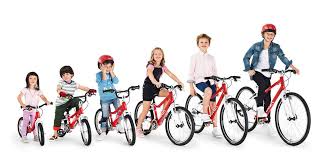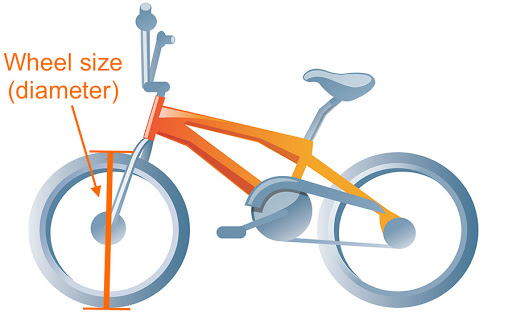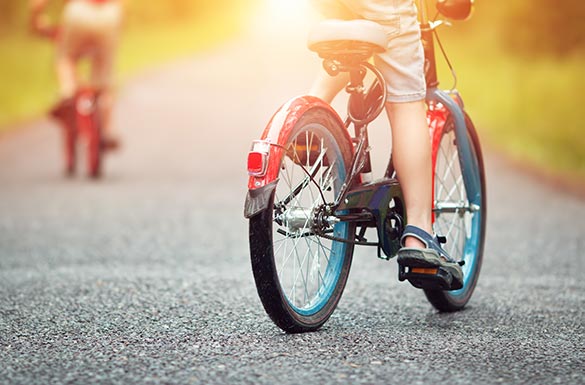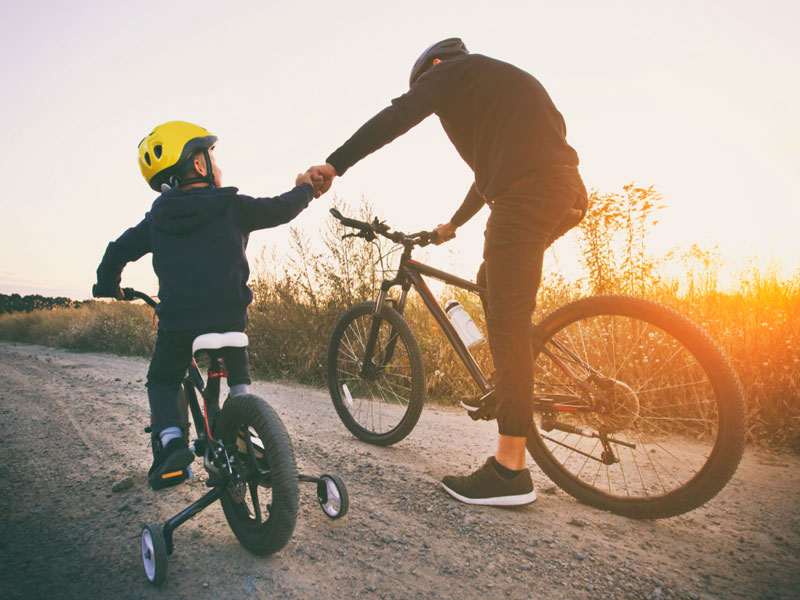Bike Purchase Series – Kids Bikes
Most kids start learning to ride a bike on a two-wheeler with training wheels. Between the ages of 4 and 8 years, most kids have developed sufficient physical coordination and agility, good balance, and master starting and stopping on a tricycle or training wheels so that they are ready to learn to ride a bicycle.

Ask any adult and no doubt they’ll be able to tell you about their first bike or the adventures they had on two wheels as a youngster. A bike provides kids freedom, confidence and everlasting memories, not to mention the development of fine motor skills and muscle development, and so choosing the right one is pretty important. There are no specific rules for buying a particular bike for a child, however, the tips below should point you in the right direction
Selecting the right size bike for a child might seem like a simple equation but there’s a lot more information to consider than age alone. Sizing of the bike is more dependent on height than age, not to mention confidence and ability.
BIKE SIZE SUGGESTED CHILD HEIGHT
Balance Bike / 12” wheel ……………………… 2’-10” – 3’-7”
16” wheel …………………………………………….. 3’-3” – 3’-11”
20” wheel kids bike * ……………………….….. 3’-9” – 4’-5”
24” wheel …………………………………………….. 4’-3” – 4’-9”
26” wheel ……………………………………..………4’-9” & taller
Standard BMX bikes have 20” wheels and are ridden by adolescents and adults
It’s important when selecting a bike that you don’t choose a size the child will ‘grow into’. As the size of a bike increases, so does its weight, making it more difficult to maneuver. Greater tire size also adds weight, as do more gears and additions like suspension, kickstands and hand operated lever brakes. An increase in height raises the center of gravity and makes it harder to balance.  As a result, if you choose a bike that is too large, your child may have difficulty riding it and not enjoy the experience. Use the height recommendations as a guide and be mindful that the best way to know if the bike is the right size is to see if the child can comfortably stand over the bike with both feet flat on the ground, comfortably reach the pedals from the seat, and comfortably reach the handlebars when sitting.
As a result, if you choose a bike that is too large, your child may have difficulty riding it and not enjoy the experience. Use the height recommendations as a guide and be mindful that the best way to know if the bike is the right size is to see if the child can comfortably stand over the bike with both feet flat on the ground, comfortably reach the pedals from the seat, and comfortably reach the handlebars when sitting.
It’s also important to note that unlike adult bikes that are measured via the frame, kids bikes are measured by wheel size, and so the size is not indicative of the frame size or seat height of the bike. As well as looking at the bikes tire size, be aware of the minimum and maximum seat height to make sure the child can fit the bike.
The material used for kids bikes can vary according to price and will affect the durability, weight and look of the bike. Most commonly kids bikes will be made from either steel or aluminium.
Steel bikes are the most cost effective option and highly durable with the ability to withstand plenty of punishment that will no doubt come its way. The downside of steel bikes is they’re significantly heavier than aluminium and can rust if left out or ridden in all weather conditions.
Aluminium bikes are light, highly durable and near rust-proof, but come at an additional cost to steel.
Kids bikes will typically begin with a single gear to not over complicate the cycling experience but as the child gets more experienced and skilled, more gears are available.
To begin with, a single speed gear normally features an easy pedaling ratio, so children have no problems turning the pedals over. If there is a still a single speed gear present as the size of the bike increases, this ratio is likely to be larger, making it harder to pedal initially, but capable of faster overall speeds.
Kids bikes are typically 25-40% of the child’s weight but that figure will be highly variable depending upon the bike you choose, the child’s weight to height ratio and age. If possible try to limit the weight of the bike to under 50% of the child’s weight. To put that in perspective, an adult’s mountain bike typically weighs between 15-20% of a 165lb rider.
There are positives and negatives when it comes to using training wheels or stabilizers. On the plus side, they provide stability, inspire confidence and can be important in the early stages of riding if children lack the strength to turn the pedals and the weight of the bike is too much. And for children that have never used a balance bike or scooter, going straight onto a pedal bike with no support is a bridge too far.
On the negative side, it’s said using training wheels teaches children bad habits and can make the progression to riding without support more difficult. They can also influence braking effectiveness when turning as the weight is on the training wheel and not on the rear wheel.
If you do use training wheels, start them level with the ground and gradually raise them as your child becomes more confident, to the point that they can almost do without them. When the child is confident enough, they can then be removed.
Prices for a kids bike will vary greatly depending on the size, material and type but below are a few things to consider when deciding on a budget, regardless of the kids bike you’re purchasing.
- Kids will grow out of their bikes in a short period of time so it’s worthwhile thinking a step ahead and deciding whether this bike will get handed down or be sold on. In either case, keep it in good condition and don’t throw away training wheels, spares, reflectors, instructions or other items that come with the initial purchase. It might also help to choose neutral colors so it can be sold to girls or boys.
- Should you buy from a specialty bike store or a department store? Bike stores have expected knowledge, will assemble the bike safely and be a point of contact if something is not right. Department stores lack the specific knowledge of bikes so you’ll likely have to assemble the bike yourself and have limited resources available to you, should something go wrong. Typically speaking, the bikes sold at bike stores are built to higher quality standards than those you find at department stores, like most things, you do get what you pay for.
- We’ve listed many possible accessories above but not all of them come with the bike as standard. As such, you should always check what comes with the bike and any possible accessories you’ll need to purchase. Basic items like reflectors, bells and brakes will come with the bike, but training wheels, kickstands and baskets may not.
** Much of the info in this post was compiled by Bikeexchange.com
